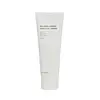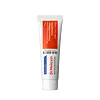What's inside
What's inside
 Key Ingredients
Key Ingredients

 Benefits
Benefits

 Concerns
Concerns

No concerns
 Ingredients Side-by-side
Ingredients Side-by-side

Centella Asiatica Leaf Water
Skin ConditioningButylene Glycol
HumectantGlycerin
HumectantCaprylic/Capric Triglyceride
MaskingHydrogenated Poly(C6-14 Olefin)
EmollientWater
Skin ConditioningPropanediol
SolventDipropylene Glycol
HumectantPentaerythrityl Tetraethylhexanoate
Emollient1,2-Hexanediol
Skin ConditioningCyclohexasiloxane
EmollientHelianthus Annuus Seed Oil
EmollientCetearyl Olivate
Sorbitan Olivate
EmulsifyingAmmonium Acryloyldimethyltaurate/Vp Copolymer
Acrylates/C10-30 Alkyl Acrylate Crosspolymer
Emulsion StabilisingTromethamine
BufferingSalmon Egg Extract
Sodium Polyacrylate
AbsorbentBetaine
HumectantPanthenol
Skin ConditioningCamellia Sinensis Leaf Water
MaskingSodium Hyaluronate
HumectantEthylhexylglycerin
Skin ConditioningXanthan Gum
EmulsifyingAdenosine
Skin ConditioningDisodium EDTA
Dextrin
AbsorbentPortulaca Oleracea Extract
Skin ConditioningHydrolyzed Collagen
EmollientTheobroma Cacao Extract
Skin ConditioningTocopherol
AntioxidantHyaluronic Acid
HumectantMadecassoside
AntioxidantSodium Dna
Skin ConditioningMaltodextrin
AbsorbentPersea Gratissima Fruit Extract
EmollientHydrolyzed Hyaluronic Acid
HumectantCentella Asiatica Leaf Water, Butylene Glycol, Glycerin, Caprylic/Capric Triglyceride, Hydrogenated Poly(C6-14 Olefin), Water, Propanediol, Dipropylene Glycol, Pentaerythrityl Tetraethylhexanoate, 1,2-Hexanediol, Cyclohexasiloxane, Helianthus Annuus Seed Oil, Cetearyl Olivate, Sorbitan Olivate, Ammonium Acryloyldimethyltaurate/Vp Copolymer, Acrylates/C10-30 Alkyl Acrylate Crosspolymer, Tromethamine, Salmon Egg Extract, Sodium Polyacrylate, Betaine, Panthenol, Camellia Sinensis Leaf Water, Sodium Hyaluronate, Ethylhexylglycerin, Xanthan Gum, Adenosine, Disodium EDTA, Dextrin, Portulaca Oleracea Extract, Hydrolyzed Collagen, Theobroma Cacao Extract, Tocopherol, Hyaluronic Acid, Madecassoside, Sodium Dna, Maltodextrin, Persea Gratissima Fruit Extract, Hydrolyzed Hyaluronic Acid
Water
Skin ConditioningGlycerin
HumectantButylene Glycol
HumectantButylene Glycol Dicaprylate/Dicaprate
EmollientPentaerythrityl Tetraisostearate
EmollientPolyglyceryl-3 Methylglucose Distearate
EmulsifyingCetearyl Alcohol
EmollientPropanediol
SolventC14-22 Alcohols
Emulsion StabilisingPalmitic Acid
EmollientPanthenol
Skin ConditioningVinyldimethicone
Stearic Acid
CleansingCarbomer
Emulsion StabilisingSodium Polyacryloyldimethyl Taurate
Emulsion StabilisingTromethamine
BufferingScutellaria Baicalensis Root Extract
AstringentC12-20 Alkyl Glucoside
EmulsifyingHydrogenated Polydecene
EmollientEthylhexylglycerin
Skin ConditioningIndigofera Tinctoria Leaf Extract
Skin ConditioningHydrolyzed Chlorella Vulgaris Extract
EmollientHydrolyzed Hemp Seed Extract
Skin ConditioningDisodium EDTA
Hydrolyzed Hibiscus Esculentus Extract
Skin ConditioningTriethoxycaprylylsilane
Allantoin
Skin ConditioningHyaluronic Acid
HumectantHydrolyzed Hyaluronic Acid
HumectantMyristic Acid
CleansingSodium Hyaluronate
HumectantLagerstroemia Indica Flower Extract
Skin ConditioningTheobroma Cacao Seed Extract
AntioxidantPentylene Glycol
Skin ConditioningDextrin
AbsorbentCaprylic/Capric Triglyceride
MaskingCentella Asiatica Leaf Extract
Skin ConditioningGlucose
HumectantMadecassoside
AntioxidantCoix Lacryma-Jobi Ma-Yuen Seed Extract
Skin ConditioningCeramide NP
Skin ConditioningHydrogenated Lecithin
EmulsifyingMadecassic Acid
Skin ConditioningAsiaticoside
AntioxidantAsiatic Acid
Skin ConditioningWater, Glycerin, Butylene Glycol, Butylene Glycol Dicaprylate/Dicaprate, Pentaerythrityl Tetraisostearate, Polyglyceryl-3 Methylglucose Distearate, Cetearyl Alcohol, Propanediol, C14-22 Alcohols, Palmitic Acid, Panthenol, Vinyldimethicone, Stearic Acid, Carbomer, Sodium Polyacryloyldimethyl Taurate, Tromethamine, Scutellaria Baicalensis Root Extract, C12-20 Alkyl Glucoside, Hydrogenated Polydecene, Ethylhexylglycerin, Indigofera Tinctoria Leaf Extract, Hydrolyzed Chlorella Vulgaris Extract, Hydrolyzed Hemp Seed Extract, Disodium EDTA, Hydrolyzed Hibiscus Esculentus Extract, Triethoxycaprylylsilane, Allantoin, Hyaluronic Acid, Hydrolyzed Hyaluronic Acid, Myristic Acid, Sodium Hyaluronate, Lagerstroemia Indica Flower Extract, Theobroma Cacao Seed Extract, Pentylene Glycol, Dextrin, Caprylic/Capric Triglyceride, Centella Asiatica Leaf Extract, Glucose, Madecassoside, Coix Lacryma-Jobi Ma-Yuen Seed Extract, Ceramide NP, Hydrogenated Lecithin, Madecassic Acid, Asiaticoside, Asiatic Acid
 Reviews
Reviews

Ingredients Explained
These ingredients are found in both products.
Ingredients higher up in an ingredient list are typically present in a larger amount.
Butylene Glycol (or BG) is used within cosmetic products for a few different reasons:
Overall, Butylene Glycol is a safe and well-rounded ingredient that works well with other ingredients.
Though this ingredient works well with most skin types, some people with sensitive skin may experience a reaction such as allergic rashes, closed comedones, or itchiness.
Learn more about Butylene GlycolThis ingredient is an emollient, solvent, and texture enhancer. It is considered a skin-softener by helping the skin prevent moisture loss.
It helps thicken a product's formula and makes it easier to spread by dissolving clumping compounds.
Caprylic Triglyceride is made by combining glycerin with coconut oil, forming a clear liquid.
While there is an assumption Caprylic Triglyceride can clog pores due to it being derived from coconut oil, there is no research supporting this.
Learn more about Caprylic/Capric TriglycerideDextrin is used to thicken a product and helps bind ingredients together. It is created from starch and glycogen.
As an emulsifier, dextrin prevents ingredients from separating. This helps elongate a product's shelf life.
Studies show coating UV filters with dextrin prevents these ingredients from being absorbed. This helps UV ingredients last longer on the skin.
Learn more about DextrinDisodium EDTA plays a role in making products more stable by aiding other preservatives.
It is a chelating agent, meaning it neutralizes metal ions that may be found in a product.
Disodium EDTA is a salt of edetic acid and is found to be safe in cosmetic ingredients.
Learn more about Disodium EDTAEthylhexylglycerin (we can't pronounce this either) is commonly used as a preservative and skin softener. It is derived from glyceryl.
You might see Ethylhexylglycerin often paired with other preservatives such as phenoxyethanol. Ethylhexylglycerin has been found to increase the effectiveness of these other preservatives.
Glycerin is already naturally found in your skin. It helps moisturize and protect your skin.
A study from 2016 found glycerin to be more effective as a humectant than AHAs and hyaluronic acid.
As a humectant, it helps the skin stay hydrated by pulling moisture to your skin. The low molecular weight of glycerin allows it to pull moisture into the deeper layers of your skin.
Hydrated skin improves your skin barrier; Your skin barrier helps protect against irritants and bacteria.
Glycerin has also been found to have antimicrobial and antiviral properties. Due to these properties, glycerin is often used in wound and burn treatments.
In cosmetics, glycerin is usually derived from plants such as soybean or palm. However, it can also be sourced from animals, such as tallow or animal fat.
This ingredient is organic, colorless, odorless, and non-toxic.
Glycerin is the name for this ingredient in American English. British English uses Glycerol/Glycerine.
Learn more about GlycerinHyaluronic acid is naturally found in healthy skin. It is a humectant, meaning it draws moisture to your skin.
This ingredient helps hydrate, soothe, and protect the skin.
What makes hyaluronic acid so hydrating? It has the capacity to bind or hold large amounts of water.
Fun fact: It is already naturally found in our bodies, such as the fluids of our eyes and our joints.
Studies find this ingredient to have anti-inflammatory and anti-microbial properties. This can help speed up wound-healing.
Hyaluronic acid can be irritating if the molecule has a low-molecular weight, or if the molecules are small.
One study found low-molecular weight hyaluronic acid to be pro-inflammatory, meaning some people may experience irritation. This is because our bodies use hyaluronic acid in the wound-healing process to signal to our bodies, via irritation, that something needs healing.
The same study found high-molecular weight hyaluronic acid to be anti-inflammatory.
These are some other common types of Hyaluronic Acid:
Learn more about Hyaluronic AcidHydrolyzed Hyaluronic Acid is a form of hyaluronic acid. It is created by the hydrolysis of hyaluronic acid with a high molecular weight. Once created, Hydrolyzed Hyaluronic Acid has a low molecular weight.
Low molecular weight HA has been shown to hydrate and increase elasticity of the skin. Increasing elasticity is also associated with reduction of wrinkle depth.
One study found topical low molecular weight hyaluronic acid may be considered for the treatment of rosacea in the adult population. However, we always recommend speaking with a professional about your skin concerns.
Hyaluronic acids are a humectant. This means they draw moisture from the air. Hyaluronic acids help moisturize, soothe, and protect the skin.
Read more about other common forms of hyaluronic acid:
Learn more about Hydrolyzed Hyaluronic AcidMadecassoside comes from the super popular skin-soothing ingredient, Centella asiatica. It is one of four active compounds found in the extract of Centella Asiatica.
Madecassoside has antioxidant, anti-inflammatory, and hydrating properties. It contains fatty acids, amino acids, beta-carotene, and phytochemicals.
One study found using Madecassoside with ascorbic acid helped reduce the signs of aging and improved skin hydration.
Learn more about MadecassosidePanthenol is a common ingredient that helps hydrate and soothe the skin. It is found naturally in our skin and hair.
There are two forms of panthenol: D and L.
D-panthenol is also known as dexpanthenol. Most cosmetics use dexpanthenol or a mixture of D and L-panthenol.
Panthenol is famous due to its ability to go deeper into the skin's layers. Using this ingredient has numerous pros (and no cons):
Like hyaluronic acid, panthenol is a humectant. Humectants are able to bind and hold large amounts of water to keep skin hydrated.
This ingredient works well for wound healing. It works by increasing tissue in the wound and helps close open wounds.
Once oxidized, panthenol converts to pantothenic acid. Panthothenic acid is found in all living cells.
This ingredient is also referred to as pro-vitamin B5.
Learn more about PanthenolPropanediol is an all-star ingredient. It softens, hydrates, and smooths the skin.
It’s often used to:
Propanediol is not likely to cause sensitivity and considered safe to use. It is derived from corn or petroleum with a clear color and no scent.
Learn more about PropanediolSodium Hyaluronate is hyaluronic acid's salt form. It is commonly derived from the sodium salt of hyaluronic acid.
Like hyaluronic acid, it is great at holding water and acts as a humectant. This makes it a great skin hydrating ingredient.
Sodium Hyaluronate is naturally occurring in our bodies and is mostly found in eye fluid and joints.
These are some other common types of Hyaluronic Acid:
Learn more about Sodium HyaluronateTromethamine helps balance the pH and improve the texture of a product. It is synthetically created.
As an emulsifier, Tromethamine prevents oil and water ingredients from separating. This helps stabilize the product and elongate a product's shelf life. Tromethamine also makes a product thicker.
Tromethamine helps balance the pH level of a product. Normal pH level of skin is slightly acidic (~4.75-5.5). The acidity of our skin is maintained by our glands and skin biome. Being slightly acidic allows our skin to create an "acid mantle". This acid mantle is a thin barrier that protects our skin from bacteria and contaminants.
Oral Tromethanmine is an anti-inflammatory drug but plays the role of masking, adding fragrance, and/or balancing pH in skincare.
1,3-Propanediol, 2-amino-2-(hydroxymethyl)-
Learn more about TromethamineWater. It's the most common cosmetic ingredient of all. You'll usually see it at the top of ingredient lists, meaning that it makes up the largest part of the product.
So why is it so popular? Water most often acts as a solvent - this means that it helps dissolve other ingredients into the formulation.
You'll also recognize water as that liquid we all need to stay alive. If you see this, drink a glass of water. Stay hydrated!
Learn more about Water